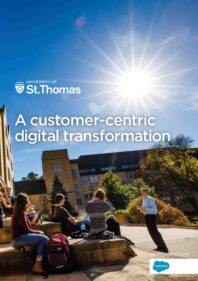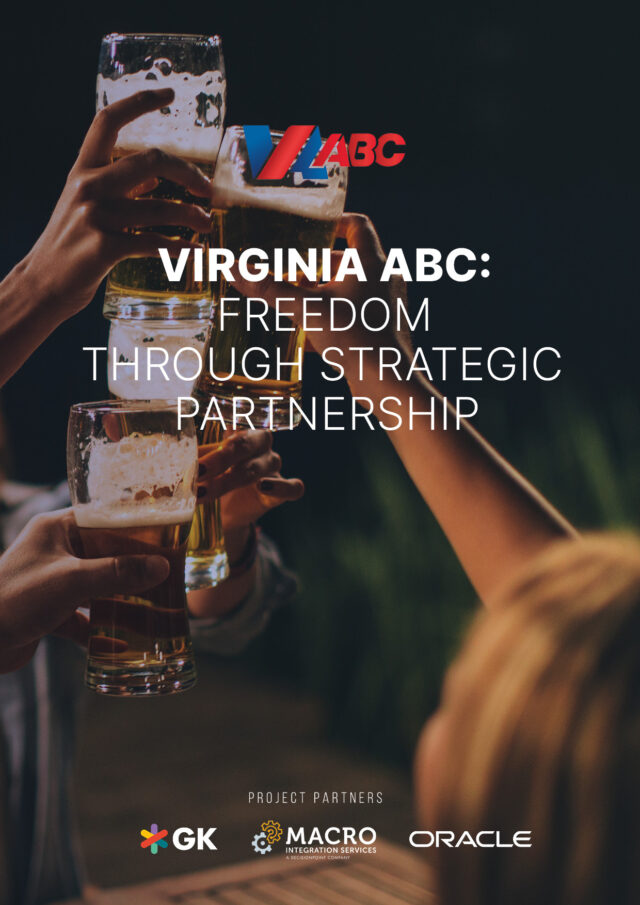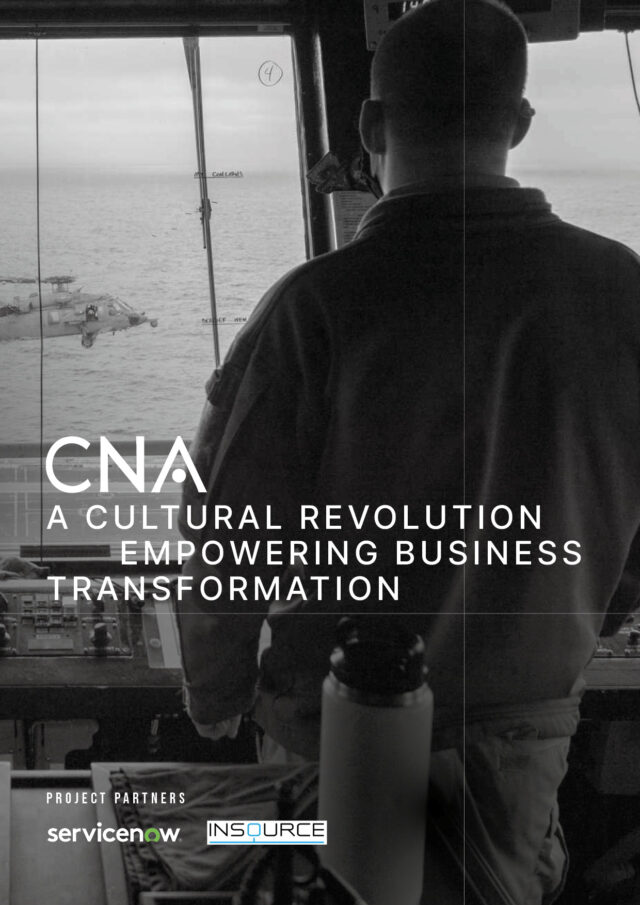We speak to Edmund Clark, Vice President for Information Technology Services, Chief Information Officer, University of St. Thomas regarding a holistic, collaborative approach to transforming the student experience.
These are challenging times for higher education with increased tuition raising expectations and new establishments popping up to challenge the old guard. Universities and colleges are having to work hard to improve the student experience and improve results while keeping one step ahead of the pack.
Ed Clark is CIO at the University of St. Thomas, based in St. Paul, Minnesota, USA. Clark joined in July 2015 to ramp up technology capabilities at the University of St. Thomas in order to create differentiation in a highly competitive market place. Founded in 1885, the University of St. Thomas is Minnesota’s largest private university, with approx. 10,000 students from 50 states and 63 countries, boasting metropolitan campuses in St. Paul, Minneapolis and Rome.
“On a very basic level, I was brought in to improve technology and increase our online learning,” Clark explains. “We wanted to be more profitable. We wanted to be more relevant. We wanted to increase our brand. We wanted to support students in unique ways that they won’t get at other universities. These bigger goals allowed me to pursue a digital transformation strategy here.”
The digital strategy at St. Thomas followed a round of technical enablement. “It wasn’t just a case of ‘how do we just make everything more digital?’ The transformation aspect of it for us was that we wanted to actually differentiate ourselves within this universe of higher ed institutions,” Clark explains. “Creating an ecosystem of offerings and support that you would not find anywhere else, would be our differentiated product. That’s where we’re hoping to get to.”
The student journey strategy aims to provide a seamless experience for the client from application and registration through to learning and graduation. In order to provide the student with a holistic journey through the various stages of a higher education, Clark and his colleagues decided to try and break down the traditional silos of university process to try and achieve a shared leadership strategy. Increasingly, universities are placing the client – the student – front and centre of its activities, as part of a customer-centric journey that encompasses all of the establishment’s operations and strategies.
“Shared leadership, I think, first and foremost comes down to having a common goal that everybody can resonate with,” says Clark. “So, one of the things I’ve been working on with my peers and colleagues across the institution is, if we say, ‘Look, we’re going to differentiate St. Thomas from everywhere else. How do we differentiate?’ It’s got to be around the student experience.”
“If I go into a room and we’re all arguing about silos and how to approach certain tasks, we can usually settle most arguments by saying, ‘What would be best for the student’s experience at this point in their journey?’ That has been a really powerful way to approach it, because as we do journey maps we address processes or procedures that have been built over time to help the administrative units but at the expense of the students. Being able to show, ‘Hey, this is really frustrating, or hard, for students to get through. They’re not even understanding the reason for it’ helps us re-think the whole thing. This helps us revamp our approaches in a way that, truthfully, I haven’t seen a lot of other universities do.”
The University has had some big wins already, from its onboarding systems through to event management and student retention. Clark sees it as “really unique” to approach operations from the student point of view rather than the administrator’s (or “silo”) view. As a CIO, Clark finds that technology is already part of every aspect of campus life as technology is embedded into everything the student does, whether it’s selecting, or even taking, courses.
Unlocking the power of data
Data drives most strategies across business and a university is a veritable mine. “We know when students come in, we have their card data. We have the classroom data. We have the partnerships across the university, to make sure all those systems integrate. I want to highlight that everyone here believes that data is going to be the key. In higher ed we typically have this stovepipe data problem, where there’s lots of great data people across the campus, but they all create their own stovepipes of data. It seems impossible to bring those clouds together into something common.”
Clark has created a role for a chief data officer who has brought all these
stovepipes together, so the data is a trusted and accurate source of
information. “So, it’s data from the
registrar, it’s institutional research, it’s all the IT stuff, all the
systems,” says Clark. “That is key to
digital transformation, because in the
end you will be able to see problems before anyone knows they’re there.” In
terms of agility across enterprise, a
collaborative, shared leadership spirit also really helps. “Because then, we
can all leap forward together. We’re
all in the room together. We’re hearing the problems together and we’re solving
them together.”
Clearly to build a collaborative ecosystem you need collaborative systems. St. Thomas has a collaborative intranet that Clark and his team have created, based on Office 365 where departments and teams can share documents, access a ticketing system and lots of data systems. “We’re hoping to make the data available to anyone, anywhere, on any device,” Clark explains. “This is going to allow us to react more quickly to the problems as they emerge. Then, when we have big wins that are clearly collaborative, that are clearly working well, we can build on them to get into bigger successes. One of our large wins in this space has been rolling out the Salesforce platform for the whole campus. We were trying to use it for an end-to-end customer journey, starting from the time we recruit them, to the time they come in to take classes and even after they leave. We want to use it to reach out to our students while engaging our entire administration. For university purposes, this engagement thing is so critical.”
One of the most frustrating processes that a student can undergo at any college is registration. “You have a certain number of classes. You’re almost fighting to get in. You often have a window: seniors go first, juniors second, so on and so forth. So, we’re trying to transform our registration process, through data that’s real time, and quick, and very responsive. They can see before they even register what’s available, which is also new. Then, also, if we can get fast enough, if we can get responsive enough, we can see that the class is full and can open a new section immediately. We have our system in the cloud so that we can scale up and scale down as demand on our systems increases and decreases. This creates a much snappier, more responsive experience for the students, where many places would see their systems bog down. These are some of the things we’re trying to do right now. The students are really excited about that.”
The achievement gap
In the United States, the average two-year graduation rate at two-year colleges is less than 20%. Graduation and retention are typically very low.
St. Thomas recently created a two-year college, the Dougherty Family College, to help address
the achievement
gap for impoverished students and students of colour
in Minnesota.
However, the president at St. Thomas has set an ambitious goal of an 80% graduation rate, which is four times the national average. “It is so inspiring, but can also seem so impossible, you know? So, here’s the goal, it’s a shared goal, we’re all in the room trying to figure out. ‘Well, how are we going to achieve this?’ So from a technology perspective, being able to use Salesforce and say, ‘Look, we’re going to have some really advanced tracking of touch points of key data’ is key. When they go to class, the day they talked to their tutors. Did they have lunch today? How are their grades doing? How’s the progress looking?’”
“Creating that system with Alvin Abraham, the dean of that two-year college guiding it, has been a huge shared win. I will say, we did not hit the goal in this first graduating class. We were aiming for 80% and we ended up getting, I think, around 60%. But when you consider that is still more than three times the national average, that’s already a huge win. Now, we’re not satisfied, we’re going to keep aiming higher, and we think we’re going to move that upward. But, that kind of win is great for the students, and it’s obviously great for our initiative here. Furthermore, you can use these win areas to become huge innovation hubs. Each of these collaborations becomes an innovation hub that can be diffused throughout the organisation.”
In terms
of collaboration, St. Thomas links all
the different departments together through a range of services such as Office 365, OneDrive, SharePoint, and an intranet as well as a common
project management platform Jira,
where people can come in and look at
the status of their projects and move forward. “In terms of our collaborative platforms we also use Microsoft Teams which is a big thing we’re
rolling out right now. So, people can chat in real time across departments and
so forth,” Clark details. “Higher education,
historically, was intentionally built to
be siloed. There’s a department of this and
a department of that. And an administrator of this and an administrator of that. That’s a purp-
oseful design. But when it comes to
digital transformation, this needs to
be broken down. The only way to do
that is by creating these collaborations
and these shared wins.”
Learning experience
Clark was also asked to lead the university’s efforts to get into online learning. “This private, Catholic university, has amazing face-to-face facilities, but we were looking to add more convenient ways for students to access their education. So, we’re really committed to technology-enhanced learning. We’re obviously committed to online learning as well. By building on our experience from designing and delivering online and blended learning, we’re hoping to move into gamifying content and creating competency-based modules to break down course work, and increase the kinds of things that students can do in a blended format. We are rapidly increasing use of the flipped classroom format where they can look at lecture material outside the classroom, and then have a more impactful discussion inside the classroom. One huge advantage for students is that they can take coursework even when their location or work schedule would have made the old approach impossible, such as during summer internships.
“We’ve
gotten such rave reviews from the students.
They’re used to coming in and taking these face-to-face lecture-based things.
We’ve grown online learning here by
over 300%, and our summer enrolment by 1000%. So, it’s been
a pretty huge shift here for us.”
Clark and his team are also developing initiatives using AI and IoT, including work with the library on a chatbot that can help students with research by looking up a piece of material and help acquire it from a system of partner libraries. “We also have another chatbot we’re trying, a virtual assistant, like Alexa where you can talk to the speaker and ask what your schedule is today, when your classes are. It can also give you a reminder: ‘Hey, you know you have a quiz this afternoon!’ Those are some of the things we’re trying to do in that space.”









